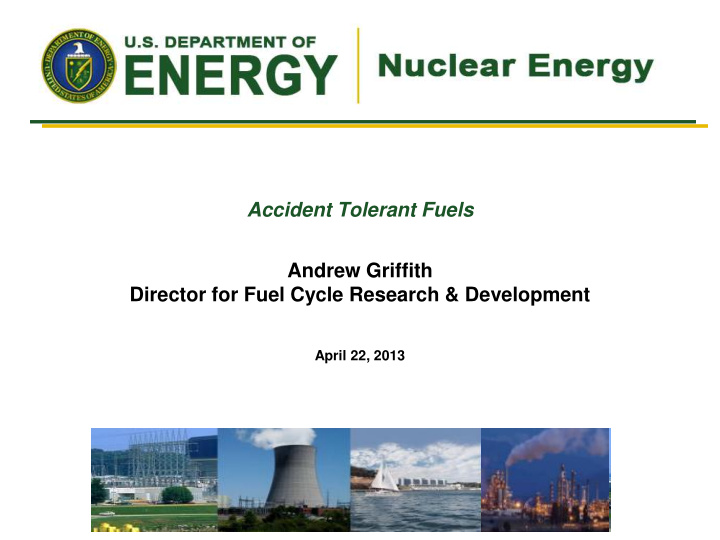



Accident Tolerant Fuels Andrew Griffith Director for Fuel Cycle Research & Development April 22, 2013
Accident Tolerant Fuel became a major focus area after Fukushima U.S. DOE fuel development program was exploring the development of next generation of LWR fuels enhanced performance. Increased burnup – reduced waste volume Increased reliability – reduced failures Higher power density – power upgrades After the unfortunate events in Fukushima (March 2011) , the U.S. congress directed the DOE to focus efforts on development of fuels with enhanced accident tolerance. Accident Tolerant Fuel development program is being implemented as a collaborative effort among National Laboratories, Industry and Universities within the U.S. Due to the nature of the problem, International collaborations can also be beneficial. 2
Major attributes of accident tolerant fuels are associated with the behavior of fuel and cladding at high temperatures. Fuels with enhanced accident tolerance are those that, in comparison with the standard UO 2 – Zircaloy system, can tolerate loss of active cooling in the core for a considerably longer time period (depending on the LWR system and accident scenario) while maintaining or improving the fuel performance during normal operations. To demonstrate the enhanced accident tolerance of candidate fuel designs, metrics must be developed and evaluated using a combination of design features for a given LWR design, potential improvements and the design of advanced fuel/cladding system. Slower Hydrogen Generation Rate Improved Reaction Kinetics with Steam - Hydrogen bubble - Heat of oxidation - Hydrogen explosion - Oxidation rate - Hydrogen embrittlement of the clad High Improved Cladding Properties temperature Improved Fuel Properties - Clad fracture during loss of - Lower operating temperatures - Geometric stability active cooling - Clad internal oxidation - Thermal shock resistance - Fuel relocation / dispersion - Melting of the cladding - Fuel melting Enhanced Retention of Fission Products -Gaseous fission products -Solid/liquid fission products 3
The new fuel design must meet the LWR operational, safety and fuel cycle constraints ECONOMICS (higher performance to offset the higher fuel cost) BACKWARD COMPATIBILITY FUEL CYCLE IMPACT (qualified in an - Enrichment existing reactor) - Storage/disposal Advanced Fuel Design, - Recycling Operations and Safety Envelope IMPACT ON SAFETY (for the entire spectrum of DBAs + IMPACT ON OPERATIONS BDBA??) - Cycle length - Reliability - Reactivity coefficients - T-H design limits 4
RD&D Strategy For Enhanced Accident Tolerant Fuels Phase 1 Phase 2 Phase 3 Feasibility Development/Qualification Commercialization Workshops Fuel Selection Feasibility studies on advanced fuel and clad concepts -- bench-scale fabrication ATR Tests - - irradiation tests - - steam reactions - - mechanical properties LTA/LTR Ready - - furnace tests - - modeling Transient Irradiation Tests LOCA/Furnace Tests Assessment of new concepts - - impact on economics - - impact on fuel cycle Fuel Performance Code - - impact on operations - - impact on safety envelope Fuel Safety Basis - - environmental impact 2015 2017 2022 2012 2013 2014 2016 2018 2019 2020 2021 5 5
Summary There are a variety of related activities that currently use DOE-NE funding to support the development of advanced LWR fuels with enhanced accident tolerance Three FOA and three IRPs were awarded in FY 2012 FOA led by experienced fuel manufacturers with deep teams IRPs led by universities (with industry and national lab participation) Work began in FY13 and continue for 2 (FOA) or 3 (IRP) years National Laboratories, Industry, and universities are providing excellent thinking and recommendations on concepts for long-term consideration, as well as for near term program efforts (e.g. in support of Accident Tolerant mission) Program, university, and industry cooperation and collaboration is strongly encouraged and will help leverage related parallel activities in a constrained budget environment 6 6
Backup Slides 7 7
Summary of major FOA, IRP, and NEUP funded ATF projects Category – Major Technology Lead Organization PI Team Members FOA, IRP, Lab, NEUP Area AREVA Protective materials, MAX phase, Paul Murray SRNL, Univ. of Wisc., FOA, NEUP and high conductivity fuel Univ. of Florida General Atomics, MIT, Westinghouse SiC Cladding, U-Si-N Fuel, Ed Lahoda FOA, NEUP U of Wisconsin, EWI, INL, LANL, TAMU LANL, U. Michigan, General Electric Advanced Steels for Cladding Raul Rebak FOA Global Nuclear Fuels ATI Wah Chang, UIUC, University of Illinois Brent Heuser NE-5 IRP Modified Zr-based cladding UM, UF, UMAN, ORNL Westinghouse, Penn University of Tennessee Ceramic Coatings for Clad Kurt Sickafus NE-5 IRP State, U. Mich., NNL Georgia Tech, U. of NE-7 IRP Michigan, Westinghouse, INL, U. Bojan Petrovic of Idaho, U. of Georgia Tech U 3 Si 2 Tennessee, Virginia Tech, Morehouse College, Southern Nuclear 8
A primary program focus is on cladding materials with more benign steam reaction Advanced steels (e.g. FrCrAl) 1000 8 hour tests 1200 C Refractory metals (e.g. Mo) 1300 C 1350 C 100 Thickness Consumed [ m] Ceramic cladding (SiC) Innovative alloys with dopants 10 Zircalloy with coating 1 SiC MAX-phase ceramics 0.1 310SS FeCrAl NITE-SiC CVD SiC Zr Each concept has some pros and cons across the spectrum of operating and transient conditions of interest. A systematic analytical and experimental evaluation is being performed during the feasibility studies. 9 9
Some new fuel concepts also are being considered Higher density fuels (metal, nitride, silicide) Higher thermal conductivity Higher fissile density to compensate for neutronic inefficiency of some new clad concepts without increasing enrichment limits Oxide fuels with additives. Pellet-Cladding Microencapsulated fuels Gap TRISO or BISO fuel dispersed in a ceramic or metallic matrix Each concept has some pros and cons across the spectrum TRISO of operating and transient conditions of interest. A systematic Particle Cladding: Zircaloy, SiC, SS analytical and experimental evaluation is being performed during the feasibility studies. 10 10
Recommend
More recommend